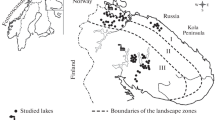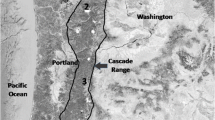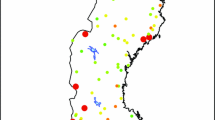Abstract
A re-survey of acid-sensitive lakes in Ireland (initial survey 1997) was carried out during spring 2007 (n = 60). Since 1997, atmospheric emissions of sulfur dioxide and deposition of non-marine sulfate (SO4 2−) in Ireland have decreased by ~63 and 36%, respectively. Comparison of water chemistry between surveys showed significant decreases in the concentration of SO4 2−, non-marine SO4 2−, and non-marine base cations. In concert, alkalinity increased significantly; however, no change was observed in surface water pH and total aluminum. High inter-annual variability in sea salt inputs and increasing (albeit non-significant) dissolved organic carbon may have influenced the response of pH and total aluminum (as ~70% is organic aluminum). Despite their location on the western periphery of Europe, and dominant influence from Atlantic air masses, the repeat survey suggests that the chemistry of small Irish lakes has shown a significant response to reductions in air pollution driven primarily by the implementation of the Gothenburg Protocol under the UNECE Convention on Long-Range Transboundary Air Pollution.




Similar content being viewed by others
References
Aherne, J., and C.J. Curtis. 2003. Critical loads of acidity for Irish lakes. Aquatic Sciences 65: 21–35.
Aherne, J., and E.P. Farrell. 2002. Deposition of sulfur, nitrogen and acidity in precipitation over Ireland: Chemistry, spatial distribution and long-term trends. Atmospheric Environment 36: 1379–1389.
Aherne, J., M. Kelly-Quinn, and E.P. Farrell. 2002. A survey of lakes in the Republic of Ireland: Hydrochemical characteristics and acid sensitivity. Ambio 31(6): 452–459.
Almer, B., W. Dickson, C. Ekström, and E. Hornström. 1978. Sulphur pollution and the aquatic ecosystem. In Sulfur in the environment, ed. J.O. Nriagu, 271–311. New York: Wiley.
Bailey, M.D., J.J. Bowman, C. O’Connell, and P.J. Flanagan. 1986. Air quality in Ireland. Dublin: An Foras Forbartha.
Bashir, W., F. McGovern, M. Ryan, and L. Burke. 2008. Chemical trends in background air quality and the ionic composition of precipitation for the period 1980–2004 from samples collected at Valentia Observatory, CoKerry, Ireland. Journal of Environmental Monitoring 10: 730–738.
Bowman, J.J. 1991. Acid sensitive waters in Ireland: The impact of a major new sulfur emission on sensitive surface waters in an unacidified region. Dublin: Environmental Research Unit.
Bowman, J.J., and M. McGettigan. 1994. Atmospheric deposition in acid sensitive areas of Ireland: the influence of wind direction and a new coal burning electricity generation station on precipitation quality. Water, Air, and Soil pollution 75: 159–175.
Bull, K., M. Johannson, and M. Kryzanowski. 2008. Impacts of the convention on long-range transboundary air pollution on air quality in Europe. Journal of Toxicology and Environmental Health: Part A 71(1): 51–55.
Butler, C.J., A. García-Suárez, and E. Pallé. 2007. Trends in cycles in long Irish Meteorological Series. Biology and Environment: Proceedings of the Royal Irish Academy 107B(3): 157–165.
Driscoll, C.T., K.M. Driscoll, K.M. Roy, and M.J. Mitchels. 2003. Chemical response of lakes in the Adirondack region of New York to declines in acidic deposition. Environmental Science and Technology 37: 2036–2042.
EMEP. 1996. Manual for sampling and chemical analysis. http://www.tarantula.nilu.no/projects/ccc/qa.
European Environmental Agency. 2009. European community emission inventory report 1990–2007 under the UNECE Convention on Long-range Transboundary Air Pollution (LRTAP). EEA Technical Report No 8/2009, Copenhagen. doi:10.2800/12414.
Evans, C.D., D.T. Monteith, and D.M. Cooper. 2005. Long-term increases in surface water dissolved organic carbon: observations, possible causes and environmental impacts. Environmental Pollution 137: 55–71.
Evans, C.D., D.T. Monteith, B. Reynolds, and J.M. Clark. 2008. Buffering of recovery from acidification by organic acids. Science of the Total Environment 404: 316–325.
Flower, R.J., B. Rippey, N.L. Rose, P. Appleby, and R.W. Battarbee. 1994. Paleolimnological evidence for the acidification and contamination of lakes by atmospheric pollution in western Ireland. Journal of Ecology 82(3): 581–596.
Fowler, D., R. Smith, J. Muller, J.N. Cape, M. Sutton, J.W. Erisman, and H. Fagerli. 2007. Long term trends in sulfur and nitrogen deposition in Europe and the cause of non-linearities. Water, Air, and Soil Pollution: Focus 7: 41–47.
Gorham, E. 1985. The chemistry of bog waters. In Chemical processes in lakes, ed. W. Stumm, 330–363. New York: Wiley.
Harriman, R., H. Anderson, and J.D. Miller. 1995. The role of sea-salts in enhancing and mitigating surface water acidity. Water, Air, and Soil pollution 85: 553–558.
Henriksen, A., M. Posch, H. Hultberg, and L. Lien. 1995. Critical loads of acidity for surface waters—can the ANClimit be considered variable? Water, Air, and Soil pollution 85(4): 2419–2424.
Hindar, A., A. Henriksen, K. Torseth, and A. Semb. 1994. Acid water and fish death. Nature 372: 327–328.
Huntrieser, H., J. Heland, H. Schlager, C. Forster, A. Stohl, H. Aufmhoff, F. Arnold, H.E. Scheel, et al. 2005. Intercontinental air pollution transport from North America to Europe: Experimental evidence from airborne measurements and surface observations. Journal of Geophysical Research Atmospheres 110: 1–22.
Jeffries, D.S., T.A. Clair, S. Couture, P. Dillon, J. Dupont, B. Keller, D. McNicol, M. Turner, et al. 2003. Assessing the recovery of lakes in southeastern Canada from the effects of acidic deposition. Ambio 32(3): 176–182.
Kähkonen, A.M. 1996. Soil geochemistry in relation to water chemistry and sensitivity to acid deposition in Finnish Lapland. Water, Air, and Soil pollution 87: 311–327.
Kernan, M., R.W. Batterbee, C.J. Curtis, D.T. Monteith, and E.M. Shilland. 2010. Recovery of lakes and streams in the UK from the effects of acid rain: UK acid waters monitoring network 20 year interpretive report, 465. London: University College London.
Kopáček, J., D. Hardekopf, V. Majer, P. Psenakova, P. Stuchlik, and J. Vesely. 2004. Response of alpine lakes and soils to changes in acid deposition: the MAGIC model applied to the Tatra Mountain region, Slovakia-Poland. Journal of Limnology 63: 143–156.
Kopáček, J., E. Stuchlik, and D. Hardekopf. 2006. Chemical composition of the Tatra Mountain lakes: Recovery from acidification. Biologia Bratislava 61: 21–33.
Moldan, F., J. Hruška, C. Evans, and M. Hauhs. 2011. Experimental simulation of the effects of extreme climatic events on major ions, acidity and dissolved organic carbon leaching from a forested catchment, Gårdsjön, Sweden. Biogeochemistry. doi:10.1007/s10533-010-9567-6
Möller, D. 1990. The Na/Cl ratio in rainwater and the seasalt chloride cycle. Tellus 42B: 254–262.
O’Brien, P.C., and T.R. Fleming. 1987. A paired Prentice–Wilcoxon test for censored paired data. Biometrics 43: 169–180.
Pilgrim, W., T.A. Clair, J. Choate, and R. Hughes. 2003. Changes in acid precipitation related water chemistry of lakes from southwestern New Brunswick, Canada, 1986–2001. Environmental Monitoring and Assessment 88: 39–52.
Reuss, J.O., and D.W. Johnson. 1986. Acid deposition and the acidification of soils and waters. New York: Springer-Verlag.
Salmi, T., A. Määttä, P. Anttila, T. Ruoho-Airola, and T. Amnell. 2002. Detecting trends of annual values of atmospheric pollutants by the Mann-Kendall test and Sen’s slope estimates—the Excel template application MAKESENS. Publications on Air Quality No. 31. Helsinki: Finnish Meteorological Institute.
Skjelkvåle, B.L., R. Wright, and A. Henriksen. 1998. Norwegian lakes show widespread recovery from acidification; Results from national surveys of lakewater chemistry 1986–1997. Hydrology and Earth System Sciences 2(4): 555–562.
Skjelkvåle, B.L., J. Mannio, A. Wilander, and T. Anderson. 2001. Recovery from acidification of lakes in Finland, Norway, and Sweden 1990–1999. Hydrology and Earth System Science 5(3): 327–337.
Skjelkvåle, B.L., C.D. Evans, T. Larsson, A. Hindar, and G.G. Raddum. 2003. Recovery from acidification in European surface waters: A view to the future. Ambio 32(3): 170–175.
Skjelkvåle, B.L., J. Stoddard, D.S. Jeffries, K. Torseth, T. Hogasen, J.J. Bowman, J. Mannio, D.T. Monteith, et al. 2005. Regional scale evidence for improvements in surface water chemistry 1991–2001. Environmental Pollution 137: 165–176.
Stoddard, J., D.S. Jeffries, A. Lükewille, T.A. Clair, P.J. Dillon, C.T. Driscoll, M. Forsius, M. Johannesson, et al. 1999. Regional trends in aquatic recovery from acidification in North America and Europe. Nature 401: 575–578.
Stuchlik, E., J. Kopáček, J. Fott, and Z. Horicka. 2006. Chemical composition of the Tatra Mountain lakes: Response to acidification. Biologia Bratislava 61: 11–20.
Sullivan, T.J., M.C. Saunders, K.A. Tonnesson, B.L. Nash, and B.J. Miller. 2005. Application of a regionalized knowledge-based model for classifying the impacts of nitrogen, sulfur, and organic acids on lakewater chemistry. Knowledge-Based Systems 18: 65–68.
Sweeney, J., T. Brereton, C. Byrne, R. Charlton, C. Emblow, C. Fealy, N. Holden, M. Jones, et al. 2003. Climate change: Scenarios and impacts. Final report. Environmental RTDI Programme 2000–2006. Environmental Protection Agency, Ireland.
UNECE. 1999. The 1999 protocol to abate acidification, eutrophication and ground-level ozone. Document ECE/EB.AIR/67. New York, Geneva: United Nations Economic Commission for Europe.
Acknowledgements
Financial support for this research was provided by the Irish Environmental Protection Agency under the Climate Change Research Programme (CCRP) 2007–2013 and the Canada Research Chair and NSERC discovery grant programs. We gratefully thank E. P. Farrell and T. Cummins for providing laboratory facilities at University College Dublin, and T. Clair for assistance with lake chemistry quality control. Finally, this work would not have been possible without the extraordinary efforts of the field crew: Jim Johnson, Brent Parsons, Tim Seabert, Koji Tominaga, Colin Whitfield and Antoni Zbieranowski.
Author information
Authors and Affiliations
Corresponding author
Rights and permissions
About this article
Cite this article
Burton, A.W., Aherne, J. Changes in the Chemistry of Small Irish lakes. AMBIO 41, 170–179 (2012). https://doi.org/10.1007/s13280-011-0177-x
Received:
Revised:
Accepted:
Published:
Issue Date:
DOI: https://doi.org/10.1007/s13280-011-0177-x




